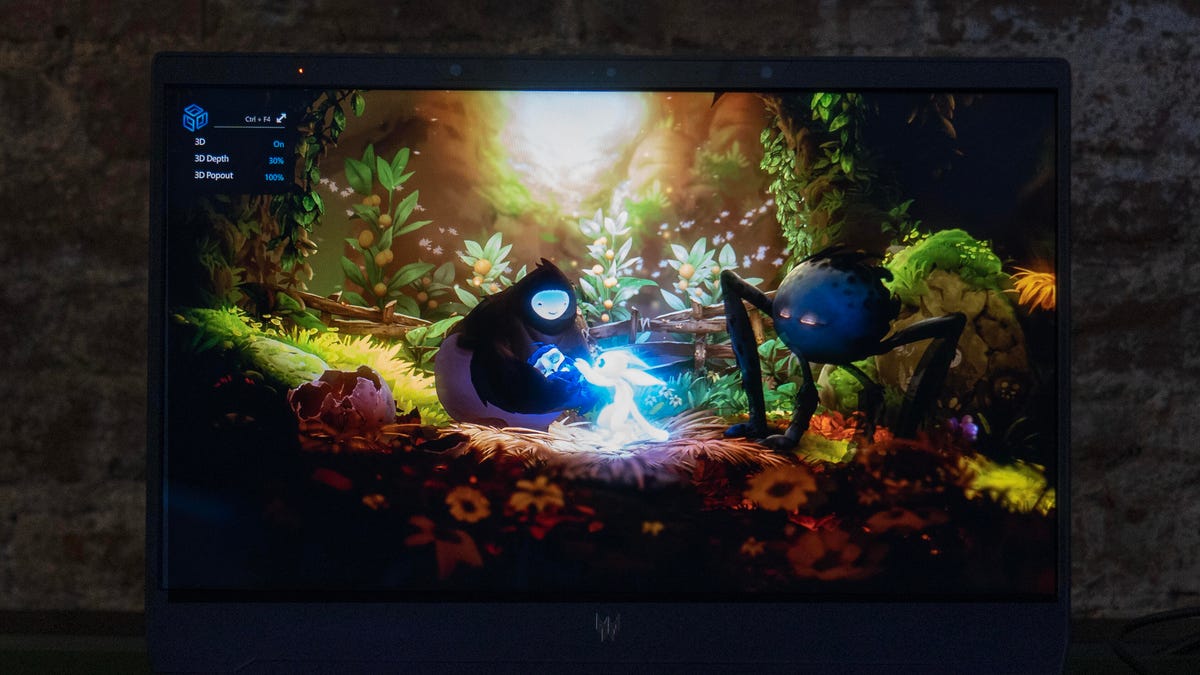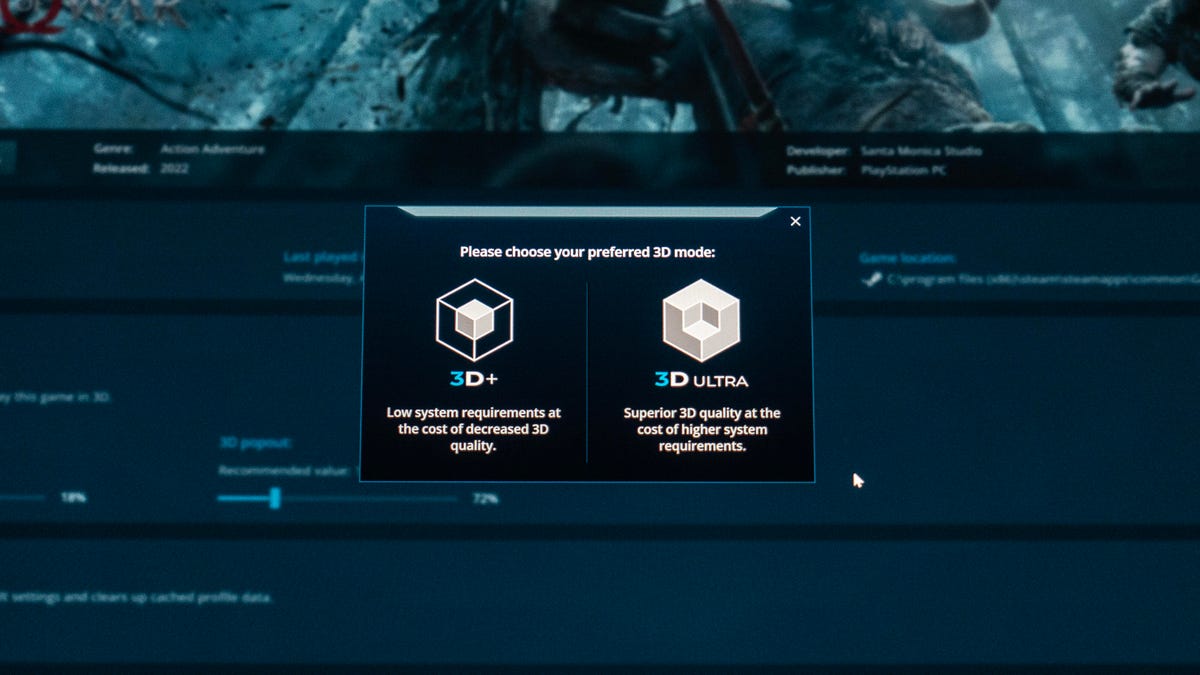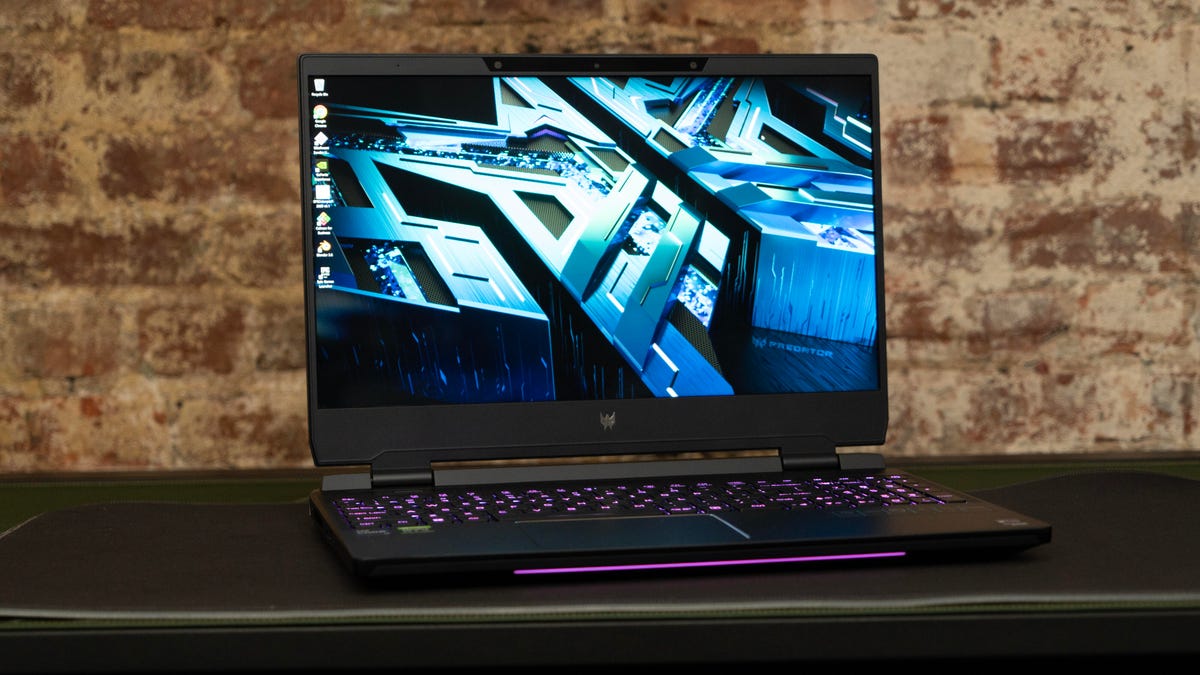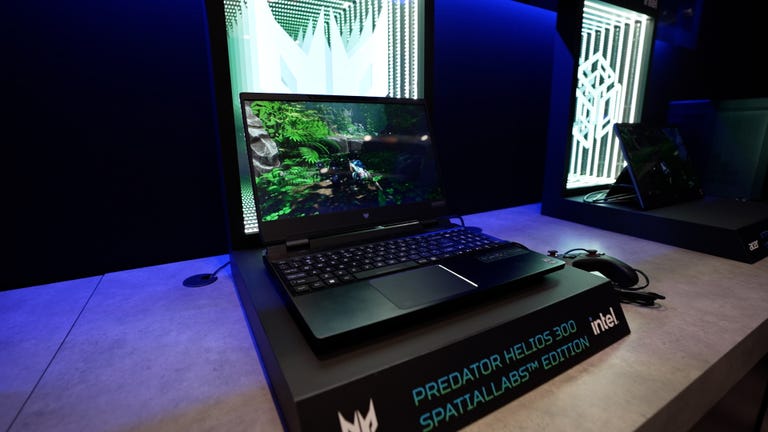
Stereoscopic 3D doesn’t translate well to photographs. But this frame from Ori and the Will of the Wisps — a 2D side-scroller — gives some idea of how the foreground and background project to provide a feeling of depth in both directions.
Plopping down in front of Acer’s Predator Helios 300 SpatialLabs Edition laptop for a few weeks and playing some games was pretty eye-opening. The technology combines a lenticular layer on the screen, an eye-tracking camera and software to split a single image into two stereoscopic ones, which let you see 3D depth without using 3D glasses. Acer’s TrueGame software takes all that and massages games for an optimal experience.
Since the screen tends to be brighter and more colorful than its surround — and it’s glossy; games really pop — it feels like you’re looking through a very clean window into a CGI world. At its best, it can make 3D games a little more immersive or 2D games even more fantastical. It can provide a more impressive preview of your 3D work and punch up your photos and videos.
But it still seems a little too rough around the edges on all counts, despite delivering an experience that jumps out at you and a fairly impressive bit of underlying tech to do so. Between my eyes having to constantly refocus on the stereoscopic 3D if I moved a little too much, software that I wanted to punch through the screen on occasion and small speed bumps on the way, I kept losing that immersive experience.
Though the model of the laptop that I looked at has since been refreshed with more modern processors — Acer has pushed it up to Core i9-13900HX and GeForce RTX 4080 graphics bumped from the i9-12900H and RTX 3080 — the older model is still for sale for $2,900, $1,100 less than its successor. It’s got a new name, too: the Predator Helios 3D 15 SpatialLabs Edition. There are some tweaks, like the ability to force the screen to always use the GPU (via a MUX switch), but the screen and 3D implementation and execution remain the same.
If you don’t feel like paying $3,500 or more for that 3D feeling, Acer also sells two standalone versions of the 15.6-inch screen. Sort of. The SpatialLabs View (ASV15-1BP) is difficult to find: Only one site had the SpatialLabs View Pro, for slightly above its $1,500 manufacturer’s price. I only found the cheaper — nominally about $1,100 — Nitro SpatialLabs View (ASV15-1B) at MicroCenter, where it was out of stock.
If you want it for more traditional design work as well, the price goes down a little more easily. It’s pretty suitable: As tested, it’s a solid Adobe RGB-accurate (with 100% gamut coverage), bright (as high as 366 nits), 15.6-inch 4K display.
I think the only difference between the two lines is the software, which corresponds to the laptop model they identify with. The Pro has the same expanded support for pro 3D design and development as Acer’s ConceptD 7 mobile workstation (another one I can’t find), which means it can work with a few more 3D design packages, has plugins for Unity and Unreal engines and so on. It also ditches the gaming support. The Nitro and Helios versions target gaming, with some support for creative applications as well. (Scroll down to see the chart on this page for more details.)
I kind of hate the name “TrueGame,” because there’s nothing true about it.
Fully dimensional


The 3D Plus option offers “low system requirements at the cost of 3D quality,” while 3D Ultra claims “superior 3D quality at the cost of higher system requirements.”
Game support falls into two buckets: 3D Ultra and 3D Plus. Ultra is higher quality and lets you control “popout,” the amount that the scene extends forward, as well as depth, how far it extends back, that both Ultra and Plus support.
Games are managed by the TrueGames app, which has custom presets for supported games and where you can adjust and save popout and depth for each game, though you can change them while in-game via hotkeys — as long as you can find a hotkey that it supports that doesn’t interfere with those you’ve got for the game (it defaults to popular ones like Ctrl 1-4).
Using the Go app, which converts visuals on the fly, I was able to view unsupported games, like The Stanley Parable: Ultra Deluxe — a slow-moving, sparsely rendered game — and it wasn’t bad.
The 3D effect is striking, especially in a game like Ori and the Will of the Wisps, where Ultra put fluttering leaves right in front of my face, close-enough seeming that I flinched. Many of the games default to a popout of 100%, which constantly struck me as too extreme. Dropping down to 75% in Ori made it a lot more comfortable.
Depth generally defaults to 30%, and you really don’t have a lot of latitude above that. In 2D games like Ori it makes the characters look like they’re floating in the air just in front of whatever surface they’re supposed to be on, and for 3D games it gives the illusion that characters extend back further, as if there’s a duplicate shadowing them. In God of War, I actually dropped the settings even more, down to 18% depth and 72% pop. God of War supports both Ultra and Plus modes, so if you’re running in the latter (which has lower overhead and quality so it runs faster) you don’t have the option to change the pop.
Games with stereoscope support built in, like Shadow of the Tomb Raider, offer some independent adjustment capability, but you still have to run them through TrueGame.
Though I concentrated mostly on gaming, I did give it a spin with Blender to see how it worked with 3D design. And if you’re thinking of it for that, you really need a second display; trying to manipulate anything while the screen’s in stereoscopic mode is extremely tricky.
Falls flat
Once the “Ohh… Shiny!” wore off, things began to irritate me. I started to get nauseous because of all the dual-refocusing my eyes had to do every time I moved; that isn’t necessarily going to be a problem for everyone, but I hadn’t expected it to be an issue for me.


Aside from the SpatialLabs frills, the Predator Helios 300 is a pretty typical enthusiast gaming laptop.
With the 4K screen, each eye sees half the horizontal resolution: 1,920×2,160 pixels per eye. That sounds like a lot but it really isn’t, notably when dealing with text. Between the coarse text, which can get bad for even large text that’s spindly in a game, and the depth effect, trying to use the menus in a game is scream-worthy. You also lose the ability to take screenshots, or at least usable ones.
And for 3D, you have to run all games in 4K, which takes a heavy toll on frame rate. The screen is also a relatively older model, which means it tops out at 60Hz, suboptimal (though not a deal-killer) for even non-FPS gaming. But it also doesn’t support HDR for gaming, which I really wouldn’t expect from the specs but kind of expect for the money.
Acer cautions that the eye-tracking camera, which keeps the stereoscope synced with your eyeline, requires sufficient light, so that may be a problem for all of us cave-players. And games need to be running full screen, though borderless full screen seemed to work as well.
All that processing means the laptop runs hot. I was always conscious of keeping my hands away from the side vents; while the air blowing out was fine, the metal could get noticeably uncomfortable to touch. It’s possible that on the newer model it isn’t as bad, but I think it’ll be similar.

 Watch this: Hands On: Acer’s 3D Stereoscopic Screen 02:10
Watch this: Hands On: Acer’s 3D Stereoscopic Screen 02:10
I think the most frustrating thing of all, though, is the software. I couldn’t figure out a way to keep it from starting, in part because there’s a whole system of services that launch it and there’s no “I’ll launch it when I want it” option. The more pressing problem is that because you can’t start it manually, you can’t stop it manually.
If I ran Go, it would prompt me every time I switched applications, like a cartoon panting dog holding a leash in its mouth inside the door. Stereoscopic or 2D — pick one! If I turned that off, it wouldn’t pop up when I did need it. I want to be able to launch it when I want and close it when I don’t. Is that too much to ask?
There’s no way to appreciate how cool SpatialLabs is without standing in front of it — the effect just doesn’t translate well to photo or video. But I think it’s got a bit of maturing to do before I’m willing to put down money for it.
